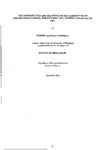THE BIOENERGETICS AND BEHAVIOUR OF THE RAINBOW TROUT (ONCORHYNCHUS MYKISS) WHEN FEEDING ON A COPPER CONTAMINATED DIET
| dc.contributor.author | CAMPBELL, HAMISH ALISTAIR | |
| dc.contributor.other | Faculty of Science and Engineering | en_US |
| dc.date.accessioned | 2013-10-25T12:09:18Z | |
| dc.date.available | 2013-10-25T12:09:18Z | |
| dc.date.issued | 2001 | |
| dc.identifier | NOT AVAILABLE | en_US |
| dc.identifier.uri | http://hdl.handle.net/10026.1/2387 | |
| dc.description.abstract |
The long-term effects of sub-lethal dietary Cu-exposure were investigated in relation to consequential energy shifts and resultant locomotory adaptation in 0. mykiss. This study represents the first to attempt to quantify the physiological cost of dietary heavy-metal exposure, the timing and extent of daily behavioural adaptation and resultant significance, in terms of ecologically important behaviours to the fish. Two long-term (2 & 3 months) dietary exposures of 730 mg Cu kgˉ¹ mg d.w. feed showed exposed fish to have a 3-fold increase in liver [Cu] and 10-fold increase in intestinal [Cu] compared to control fish. Consequently exposed fish elicited a detoxification response, and metallothionein production was also greatly increased in these tissues. Cu-uptake was regulated into the body and physiological homeostasis was maintained although a 2-fold increase in lipid peroxidation product was found in the liver of exposed fish. Simultaneous analysis of voluntary spontaneous swimming and VO2. showed exposed fish to have a 1.52 mmol 02 kgˉ¹ hˉ¹ increase over controls, and it was also shown that the cost of routine metabolism became more critical for exposed fish at higher swimming speeds. Although results further showed that the increase in both standard metabolism and routine metabolism over controls by Cu-exposed fish varied greatly between individuals. The increased energetic requirement to remain active when feeding on a Cu-contaminated diet was off-set by a reduction in swimming activity. Growth rates remained indifferent between treatments suggesting that the reduction in activity fully compensated for the increased cost of standard, and routine metabolism in exposed fish. Finite behavioural analyses over the 24-h cycle showed control fish to display periodicity in specific swimming speed, peaking in activity during the night-dawn period. Cu-exposed fish exhibited a different circadian behavioural profile, lacking distinct periodicity in specific swimming speed favouring low-level activity during the night-dawn period, and investing in higher cost swimming activity only during feeding periods. It was suggested that the high swimming activity of control fish during non-feeding periods was associated with inter-individual competition and development of the feeding hierarchy. Direct observation of trout social groups, showed a 50% reduction in the activity of the alpha fish leading to a similarly sized reduction in encounters with subordinates when the group was feeding on a Cu-contaminated diet. Consequently, a general reduction was observed in the strength of the feeding hierarchy, measured as a reduction in the size disparity between individuals within a discrete social group, and a reduction in social stress effects on subordinate fish estimated from lactate accumulation within the muscle. Feeding hierarchies are a result of initial paired interactions, and direct behavioural examination showed that fish feeding on a Cu-contaminated diet were less willing to compete in expensive escalated interactions, favouring withdrawal at a lower level of energetic investment. This lower withdrawal threshold in Cu-exposed fish, was suggested to be related to lower self-assessment of Resource Holding Power (RHP), due to the increased metabolic costs of routine metabolism in Cu-exposed fish, and a reduced resource value of a contaminated diet. The results of this investigation are discussed with regard to energetic decisions undertaken by the fish, associated with the relative costs and benefits of investing energy into growth or activity, to maximise net energy intake (food) when feeding in a social group. And how evaluation of strategies to maximise net energy gain may become more critical in rainbow trout when feeding on a Cu-contarninated diet. | en_US |
| dc.language.iso | en | en_US |
| dc.publisher | University of Plymouth | en_US |
| dc.title | THE BIOENERGETICS AND BEHAVIOUR OF THE RAINBOW TROUT (ONCORHYNCHUS MYKISS) WHEN FEEDING ON A COPPER CONTAMINATED DIET | en_US |
| dc.type | Thesis | |
| dc.identifier.doi | http://dx.doi.org/10.24382/4550 |
Files in this item
This item appears in the following Collection(s)
-
01 Research Theses Main Collection
Research Theses Main


